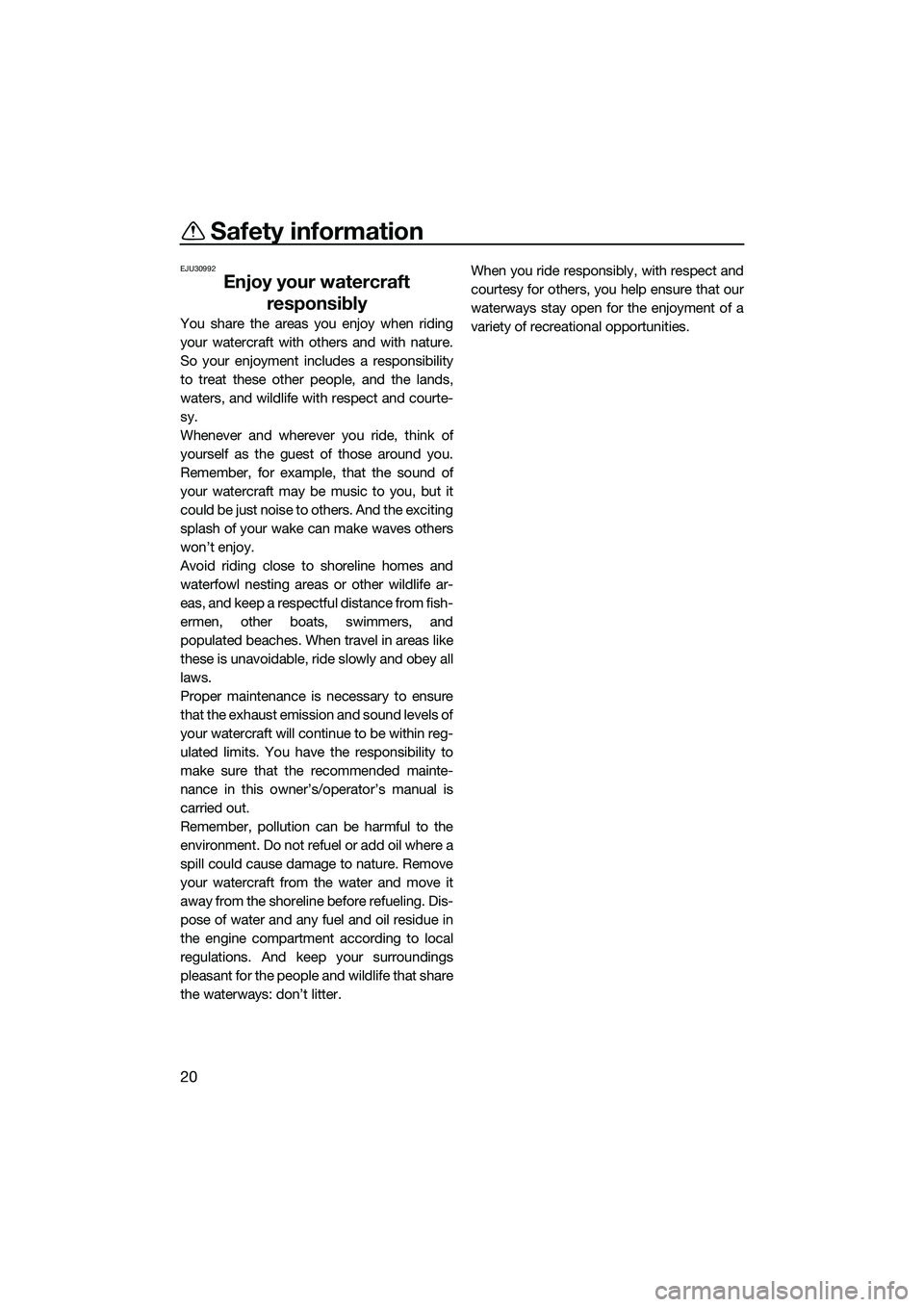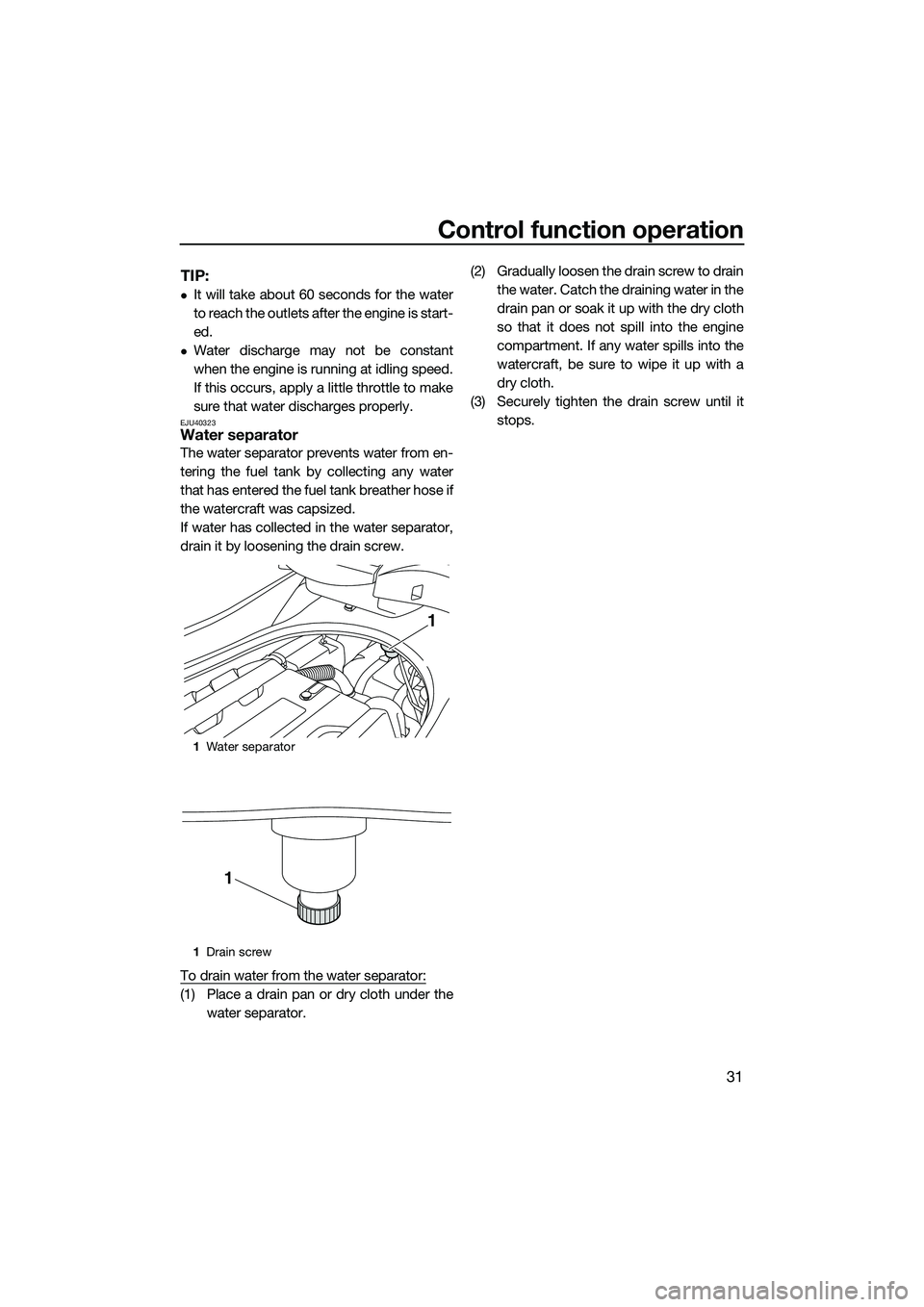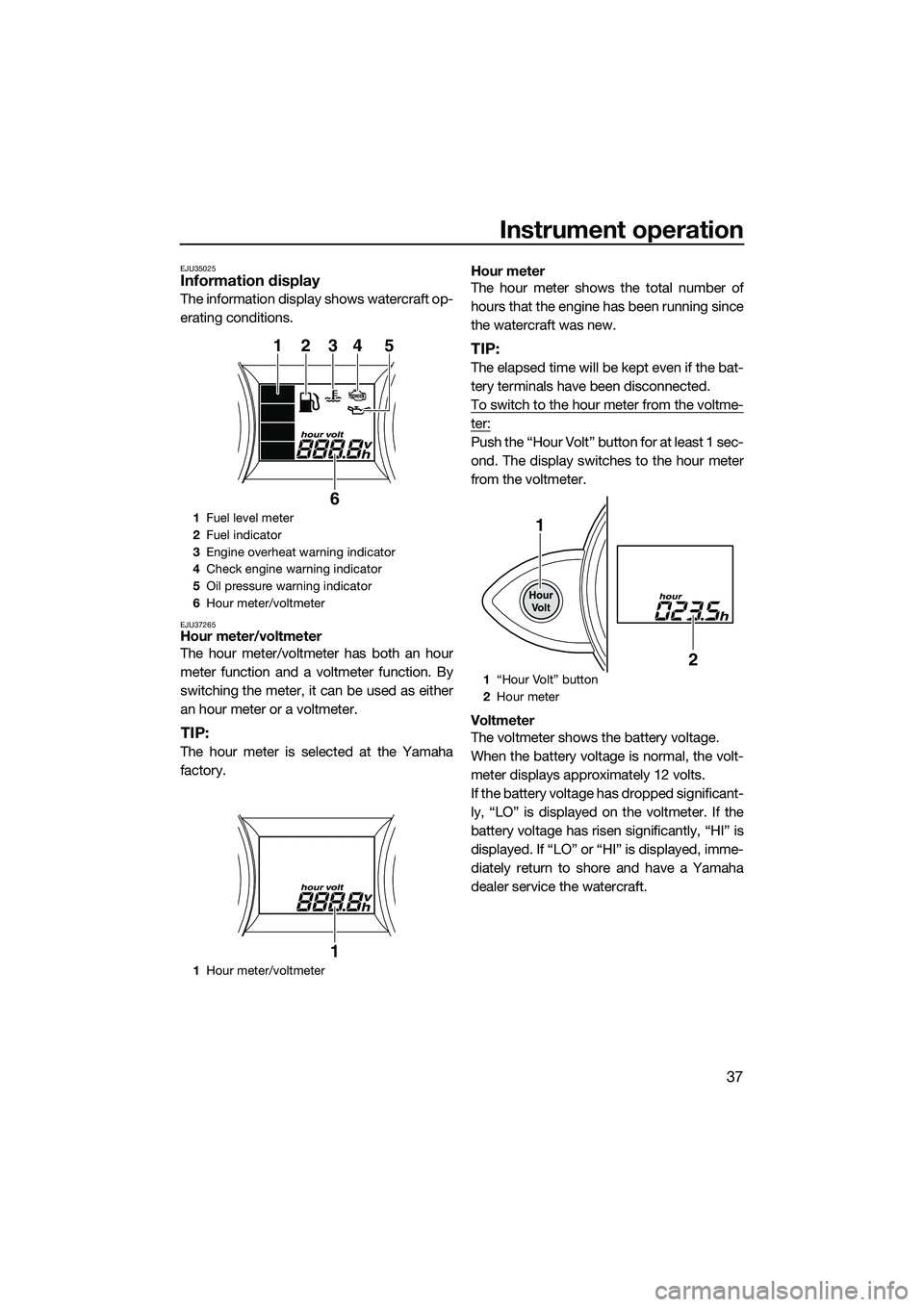2015 YAMAHA FZS SVHO fuel
[x] Cancel search: fuelPage 3 of 106

Important manual information
EJU42741
Declaration of Conformity for Personal Watercraft (PWC)
with the requirements of Directive 94/25/EC, as amended by Directive 200\
3/44/EC
Name of PWC Manufacturer: YAMAHA MOTOR CO., LTD.
Name / Title:Y. Henmi / General Manager of Engineering Section, WV Business Unit
Address:
2500 Shingai, Iwata, Shizuoka 438-8501, Japan
Name of Authorised Representative: YAMAHA MOTOR EUROPE N.V.
Address: Koolhovenlaan 101, 1119 NC Schiphol-Rijk, The Netherlands
Name of Notified Body for exhaust and noise emission assessment: SNCH
GX1800A-P / FZS SVHO 0499
ID Number:
Address: 11, route de Luxembourg BP 32, Sandweiler, L-5230. Luxembourg
US-YAMA1001H415
Conformity assessment module used:
for construction:
for exhaust emissions:
for noise emissions:
DESCRIPTION OF CRAFT
DESCRIPTION OF ENGINE A
A
Craft model Identification Number, starting from :
Model name / Commercial name : C
Design Category : Other Community Directives applied
Directive 2004/108/EC relating to electromagnetic compatibility (EMC).\
CISPR 12
Directive 2006/42/EC relating to Machinery. Standards
EN 61000-6-2
D
Aa
AaB+C
B+CB+D
B+D B+E
B+EB+F
B+FG
G
GH
H
H
Engine Type:
PWC engine Combustion cycle:
4 stroke
Fuel Type:
Petrol
ESSENTIAL REQUIREMENTS
IDENTIFICATION OF ENGINE COVERED BY THIS DECLARATION OF CONFORMITY
Name of engine model
6EV Name / ID number of Notified Body
SNCH / 0499
EC Type–examination certificate number
SNCH*94/25*2003/44*0076
(identification of the person empowered to sign on behalf of the manufa\
cturer)
Signature:(or an equivalent marking)Date and place of issue:1st / August / 2014, Shizuoka, Japan
Essential requirements
standardsother normative
document / method technical filePlease specify in more detail
(* = mandatory standard)
I.A design and construction EN ISO 13590
I.B exhaust emission *EN ISO 8178-1
I.C noise emission *EN ISO 14509
*
*
This declaration of conformity is issued under the sole responsibility o\
f the manufacturer. I declare on behalf of the PWC
manufacturer that the craft model(s) and engine(s) mentioned above c\
omplies (comply) with all applicable essential
requirements in the way specified and is (are) in conformity with the \
type(s) for which above mentioned EC type-examination
certificate(s) has (have) been issued.
ID Number:
UF3K71E0.book Page 1 Monday, August 18, 2014 2:54 PM
Page 5 of 106

Table of contents
General and important labels ........... 1Identification numbers .................... 1
Primary Identification (PRI-ID)
number............................................ 1
Craft Identification Number (CIN) ....... 1
Engine serial number.......................... 1
Manufactured date label .................... 2
Model information ........................... 2
Builder’s plate .................................... 2
Important labels .............................. 4
Warning labels.................................... 5
Other labels ........................................ 9
Safety information ........................... 11 Limitations on who may operate the watercraft ............................. 11
Cruising limitations ........................ 12
Operation requirements ................ 13
Recommended equipment ........... 15
Hazard information........................ 16
Watercraft characteristics ............. 16
Wakeboarding and water-skiing ... 18
Safe boating rules ......................... 19
Enjoy your watercraft responsibly ................................. 20
Description....................................... 21 Watercraft glossary ....................... 21
Location of main components ...... 22
Control function operation ............. 26 Watercraft control functions ......... 26
Remote control transmitter .............. 26
Yamaha Security System ................. 27
Engine stop switch .......................... 28
Engine shut-off switch .................... 28
Start switch ..................................... 28
Throttle lever .................................... 29
Steering system ............................... 29
Telescopic steering system.............. 30
Cooling water pilot outlets ............... 30
Water separator................................ 31
Watercraft operation ...................... 32Watercraft operation functions ..... 32
Reverse system ................................ 32
Quick Shift Trim System
(Q.S.T.S.) ....................................... 32
Watercraft operation modes ......... 34
Low RPM Mode ............................... 34
Instrument operation ...................... 36Dual analog meter unit.................. 36
Speedometer.................................... 36
Tachometer ...................................... 36
Information display ........................... 37
Equipment operation ...................... 41Equipment..................................... 41
Seats ................................................ 41
Handgrips ......................................... 42
Reboarding grip................................ 42
Reboarding step ............................... 42
Bow eye............................................ 43
Stern eyes ........................................ 43
Cleat ................................................. 43
Storage compartments .................... 44
Fire extinguisher holder and cover ... 47
Operation and handling
requirements ................................... 49Fuel requirements ......................... 49
Fuel................................................... 49
Engine oil requirements ................ 51
Engine oil .......................................... 51
Draining the bilge water ................ 52
Draining the bilge water on land....... 52
Draining the bilge water on water .... 53
Transporting on a trailer................ 54
First-time operation ........................ 55 Engine break-in............................. 55
Pre-operation checks ..................... 56
Pre-operation checklist .................... 56
UF3K71E0.book Page 1 Monday, August 18, 2014 2:54 PM
Page 26 of 106

Safety information
20
EJU30992
Enjoy your watercraft responsibly
You share the areas you enjoy when riding
your watercraft with others and with nature.
So your enjoyment includes a responsibility
to treat these other people, and the lands,
waters, and wildlife with respect and courte-
sy.
Whenever and wherever you ride, think of
yourself as the guest of those around you.
Remember, for example, that the sound of
your watercraft may be music to you, but it
could be just noise to others. And the exciting
splash of your wake can make waves others
won’t enjoy.
Avoid riding close to shoreline homes and
waterfowl nesting areas or other wildlife ar-
eas, and keep a respectful distance from fish-
ermen, other boats, swimmers, and
populated beaches. When travel in areas like
these is unavoidable, ride slowly and obey all
laws.
Proper maintenance is necessary to ensure
that the exhaust emission and sound levels of
your watercraft will continue to be within reg-
ulated limits. You have the responsibility to
make sure that the recommended mainte-
nance in this owner’s/operator’s manual is
carried out.
Remember, pollution can be harmful to the
environment. Do not refuel or add oil where a
spill could cause damage to nature. Remove
your watercraft from the water and move it
away from the shoreline before refueling. Dis-
pose of water and any fuel and oil residue in
the engine compartment according to local
regulations. And keep your surroundings
pleasant for the people and wildlife that share
the waterways: don’t litter. When you ride responsibly, with respect and
courtesy for others, you help ensure that our
waterways stay open for the enjoyment of a
variety of recreational opportunities.
UF3K71E0.book Page 20 Monday, August 18, 2014 2:54 PM
Page 27 of 106

Description
21
EJU40303
Watercraft glossary
Trolling speed
“Trolling” is the lowest maneuvering speed. You are applying little or no throttle. The water-
craft is down in the water, and there is no wake.
Sub-planing speed
“Sub-planing” is a medium speed. The bow of the watercraft is slightly up from the water sur-
face, but you are still traveling through the water. There is a wake.
Planing speed
“Planing” is a faster speed. The watercraft is more level and is skimming on top of the water.
There is a wake.
Bow
The front end of the watercraft.
Stern
The rear end of the watercraft.
Starboard
The right side of the watercraft when facing forward.
Port
The left side of the watercraft when facing forward.
Bilge water
Water that has collected in the engine compartment.
Yamaha Engine Management System (YEMS) YEMS is an integrated, computerized management system that controls and adjusts ignition
timing, fuel injection, engine diagnostics, and the off-throttle steering (OTS) system.
UF3K71E0.book Page 21 Monday, August 18, 2014 2:54 PM
Page 28 of 106

Description
22
EJU31012
Location of main components
Exterior
12 3
4
56
10
9
8
7
1 Fuel filler cap (page 49)
2 Hood
3 Handlebar
4 Rear seat (page 41)
5 Front seat (page 41)
6 Footwell
7 Bow eye
8 Cooling water pilot outlet (page 30)
9 Gunwale
10 Sponson
UF3K71E0.book Page 22 Monday, August 18, 2014 2:54 PM
Page 31 of 106

Description
25
Engine compartment
12
3
4 6
5
10 11
8
97
1 Engine cover
2 Air filter case
3 Water separator (page 31)
4 Fuel tank
5 Battery (page 59)
6 Flushing hose connector
7 Watertight storage compartment
8 Spark plug/Spark plug cap/Ignition coil
9 Electrical box
10 Engine oil filler cap (page 51) 11
Dipstick
UF3K71E0.book Page 25 Monday, August 18, 2014 2:54 PM
Page 37 of 106

Control function operation
31
TIP:
It will take about 60 seconds for the water
to reach the outlets after the engine is start-
ed.
Water discharge may not be constant
when the engine is running at idling speed.
If this occurs, apply a little throttle to make
sure that water discharges properly.
EJU40323Water separator
The water separator prevents water from en-
tering the fuel tank by collecting any water
that has entered the fuel tank breather hose if
the watercraft was capsized.
If water has collected in the water separator,
drain it by loosening the drain screw.
To drain water from the water separator:
(1) Place a drain pan or dry cloth under thewater separator. (2) Gradually loosen the drain screw to drain
the water. Catch the draining water in the
drain pan or soak it up with the dry cloth
so that it does not spill into the engine
compartment. If any water spills into the
watercraft, be sure to wipe it up with a
dry cloth.
(3) Securely tighten the drain screw until it stops.
1Water separator
1 Drain screw
1
1
UF3K71E0.book Page 31 Monday, August 18, 2014 2:54 PM
Page 43 of 106

Instrument operation
37
EJU35025Information display
The information display shows watercraft op-
erating conditions.
EJU37265Hour meter/voltmeter
The hour meter/voltmeter has both an hour
meter function and a voltmeter function. By
switching the meter, it can be used as either
an hour meter or a voltmeter.
TIP:
The hour meter is selected at the Yamaha
factory.Hour meter
The hour meter shows the total number of
hours that the engine has been running since
the watercraft was new.
TIP:
The elapsed time will be kept even if the bat-
tery terminals have been disconnected.
To switch to the hour meter from the voltme-
ter:
Push the “Hour Volt” button for at least 1 sec-
ond. The display switches to the hour meter
from the voltmeter.
Voltmeter
The voltmeter shows the battery voltage.
When the battery voltage is normal, the volt-
meter displays approximately 12 volts.
If the battery voltage has dropped significant-
ly, “LO” is displayed on the voltmeter. If the
battery voltage has risen significantly, “HI” is
displayed. If “LO” or “HI” is displayed, imme-
diately return to shore and have a Yamaha
dealer service the watercraft.
1
Fuel level meter
2 Fuel indicator
3 Engine overheat warning indicator
4 Check engine warning indicator
5 Oil pressure warning indicator
6 Hour meter/voltmeter
1 Hour meter/voltmeter
12345
6
1
1 “Hour Volt” button
2 Hour meter
1
2
UF3K71E0.book Page 37 Monday, August 18, 2014 2:54 PM